Planning for a Boat-Trailer Breakdown
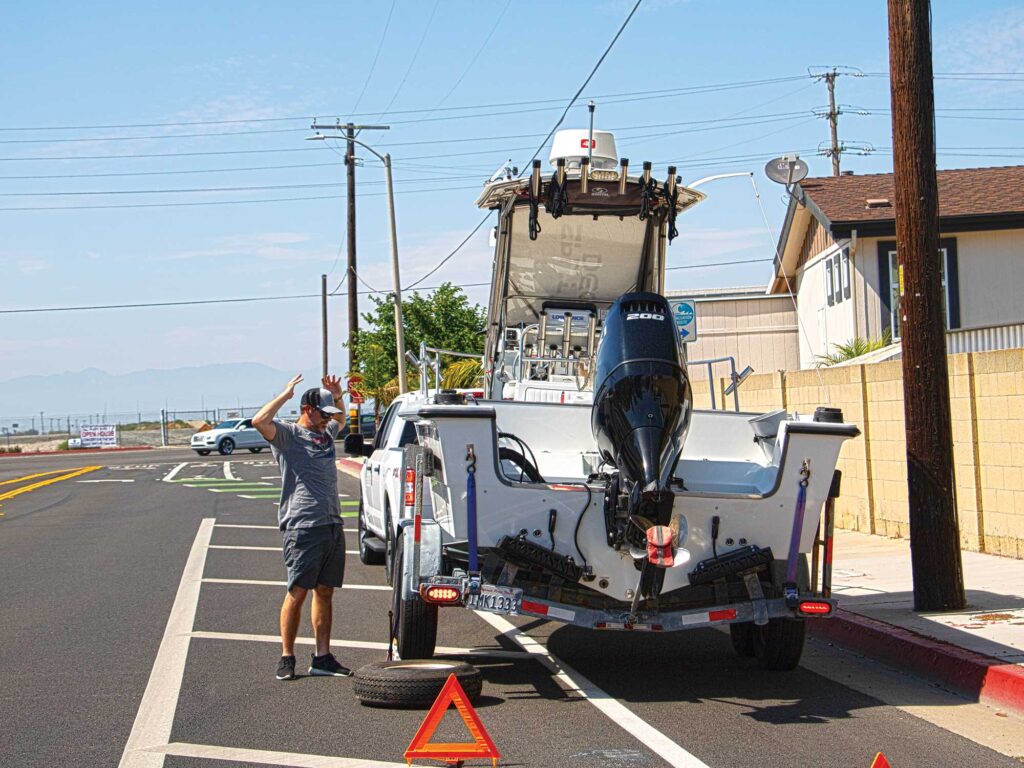 The key to dealing with a boat-trailer breakdown lies in advance planning.
Jim Hendricks
The key to dealing with a boat-trailer breakdown lies in advance planning.
Jim Hendricks
From the front seat of my brother’s SUV, I smelled the faintest whiff of scorched metal but paid little heed—until, that is, we reached the launch-ramp parking lot, got out, and saw the sizzling-hot right wheel hub on the single-axle trailer. The bearing protector was MIA, the lubricating grease had vaporized, bearings and spindle had burned to a crisp, and the now-wobbly rim was barely attached.
We felt fortunate to make it this far, but clearly the hourlong return trip with the boat in tow was not in the cards. With a crippled trailer on our hands, the big question remained: What now? The good news is that we eventually came up with solution. I will explain more later.
In the meantime, it’s no exaggeration to say that most boat-trailer breakdowns ruin trips, and can leave you and your crew in dire straits and even life-threatening situations.
Almost every trailer boater has had a breakdown, and those who have not probably will someday. The sooner you realize that, the sooner you can begin preparing for such a possibility. A big part of the prep should focus on what could go wrong, taking measures to minimize the risks, and having the right items along in case of an actual emergency.
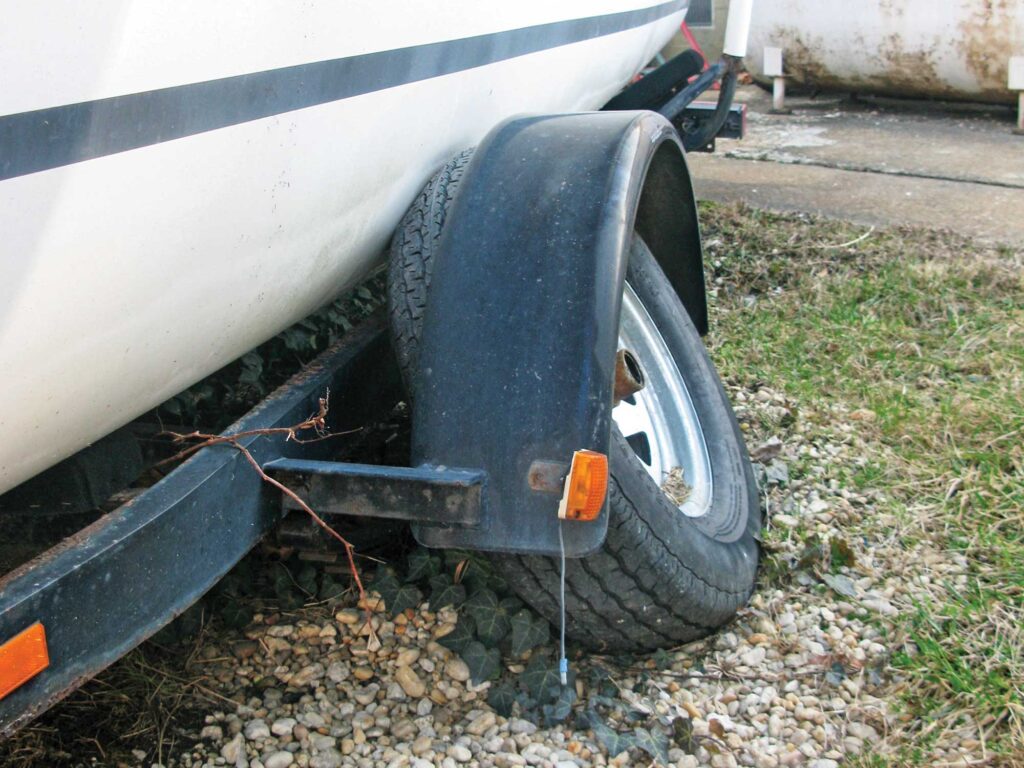 Wheel bearing and tire issues are two of the most common causes of trailer troubles.
Jim Hendricks
Common Catastrophes
Wheel bearing and tire issues are two of the most common causes of trailer troubles.
Jim Hendricks
Common Catastrophes
A wide array of issues plague trailer boaters, but two of the most common are tire blowouts and burnt wheel hubs, according to Gary Jacobs, a BoatUS Trailer Assist provider, who has been manning a wrecker since 1986. Jacobs started in the mid-1990s as a provider for BoatUS Trailer Assist, which is an optional $15 annual upgrade available when boaters sign up for the TowBoatUS on-water towing services. A Trailer Assist provider will transport your trailer boat free of charge one time up to 100 miles if you suffer a trailer breakdown.
Knowing that tire and bearing issues are major culprits in trailer breakdowns, Jacobs emphasizes the need to pay special attention to maintaining these elements. “Check your trailer tires for rot such as cracks in the sidewalls, and replace them immediately if they show this,” he advises. Sometimes trailer tires can rot from the inside, so it is a good idea to replace them every five years whether they look good on the outside or not, Jacobs adds. And make sure that you buy only trailer tires bearing the ST (special trailer) designation on the sidewalls. These have special sidewall reinforcements and other features specifically engineered to withstand the rigors of trailering.
Even with good trailer tires, make sure they are aired up to the maximum-rated psi designated on the sidewall, Jacobs says. Tires naturally lose air pressure over the months, so it is important to check the psi with a tire gauge on a regular basis. Underinflated tires can weaken sidewalls and lead to dangerous blowouts while on the road.
Jacobs also recommends inspecting the wheel bearings before every trip, looking for signs such as rusty-looking grease leaking out of the front or rear seals of the hubs (a sign of water intrusion) or wobbly wheels (an indicator that the bearings are shot). A complete wheel-bearing service at least once a year is mandatory, he believes. These steps help ensure that you spot any issues early, before they lead to a breakdown, Jacobs points out.
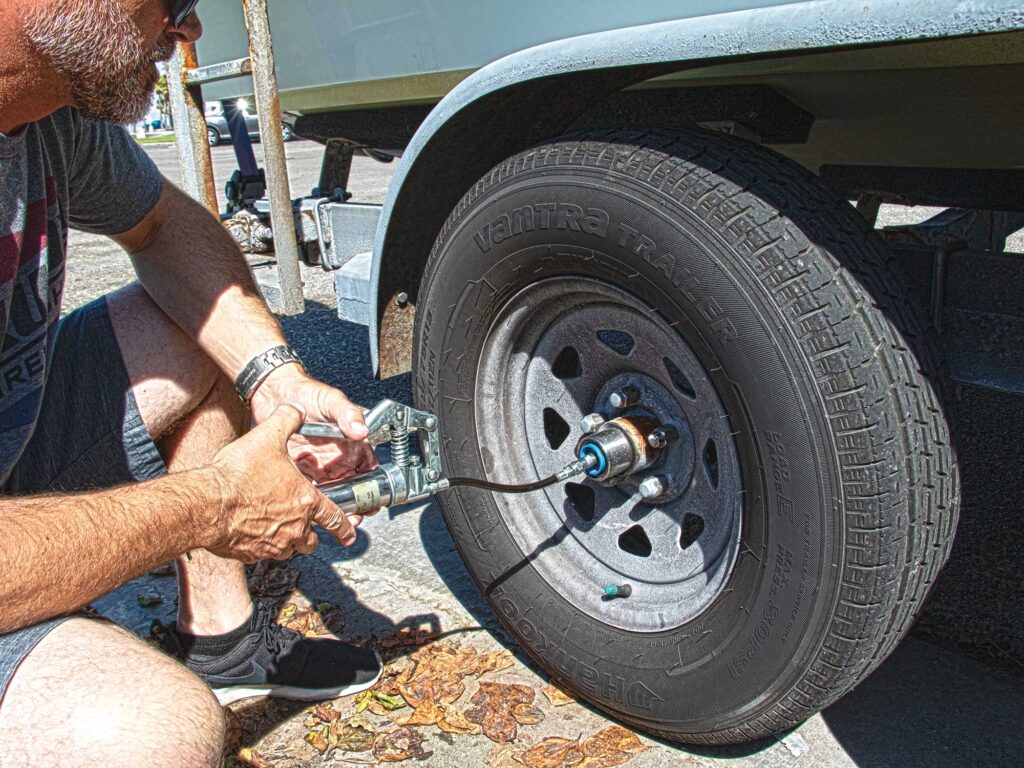 A grease gun is a good tool to have on hand.
Jim Hendricks
Spare Parts and Tools
A grease gun is a good tool to have on hand.
Jim Hendricks
Spare Parts and Tools
Even for boaters who practice fastidious maintenance, break-downs might still occur, so Jacobs suggests carrying a few spare parts and some tools to deal with these situations. Among the most basic is a spare tire to replace one that may have blown out, suffered a puncture, or become unusable due to
road-hazard damage. You can carry the spare in the back of your truck or with a spare-tire carrier on the frame of your trailer.
 A fully loaded boat and trailer require a proper jack.
Courtesy of Big Red
BUY NOW
A fully loaded boat and trailer require a proper jack.
Courtesy of Big Red
BUY NOW
Jacobs endorses the idea of carrying a properly rated jack for changing trailer tires. “Forget about using the jack that came with your vehicle,” Jacobs advises. Many times these jacks prove insufficient for lifting a fully loaded boat and trailer. “Buy a 1.5-ton rolling floor jack and carry it when you tow the boat,” he says.
An alternative for trailers with tandem torsion axles is a ramp to lift the good tire, which also elevates the bad one.
“A true star wrench that fits the lug nuts on your trailer wheel is the best tool to change a tire,” Jacobs says. “Forget about those fold-down star wrenches.” Though fold-down versions are easy to stow, they will break on you at the worst possible time, the longtime wrecker advises. It’s also a good idea to periodically loosen and retighten the trailer lugs to help ensure that they do not become frozen with corrosion, especially if you launch in salt water.
 A spare wheel hub can come in handy.
Courtesy of CE Smith
BUY NOW
A spare wheel hub can come in handy.
Courtesy of CE Smith
BUY NOW
Another item that Jacobs recommends is a spare wheel hub, preassembled with new bearings and seals, and packed with fresh grease. This can help salvage a trip if you burn up a hub but the spindle on the axle is still in usable condition. “Changing a wheel hub is pretty easy,” Jacobs says, “but you will need a few tools, including some pliers to deal with the cotter pin and spindle nut, as well as a dead-blow hammer to remove and reinstall the bearing protector.” You also should carry a grease gun and plenty of clean rags to wipe up the grease, as well as a flashlight or headlamp in case of a nighttime breakdown.
Also highly recommended is a set of reflective road triangles or flashing LED road lights to space out about 150 feet behind your rig if you need to pull over. These safety items help warn other motorists of your presence on the roadside as they approach, and are especially helpful at night.
Read Next: Understanding & Maintaining Proper Boat Trailer Tire Pressure
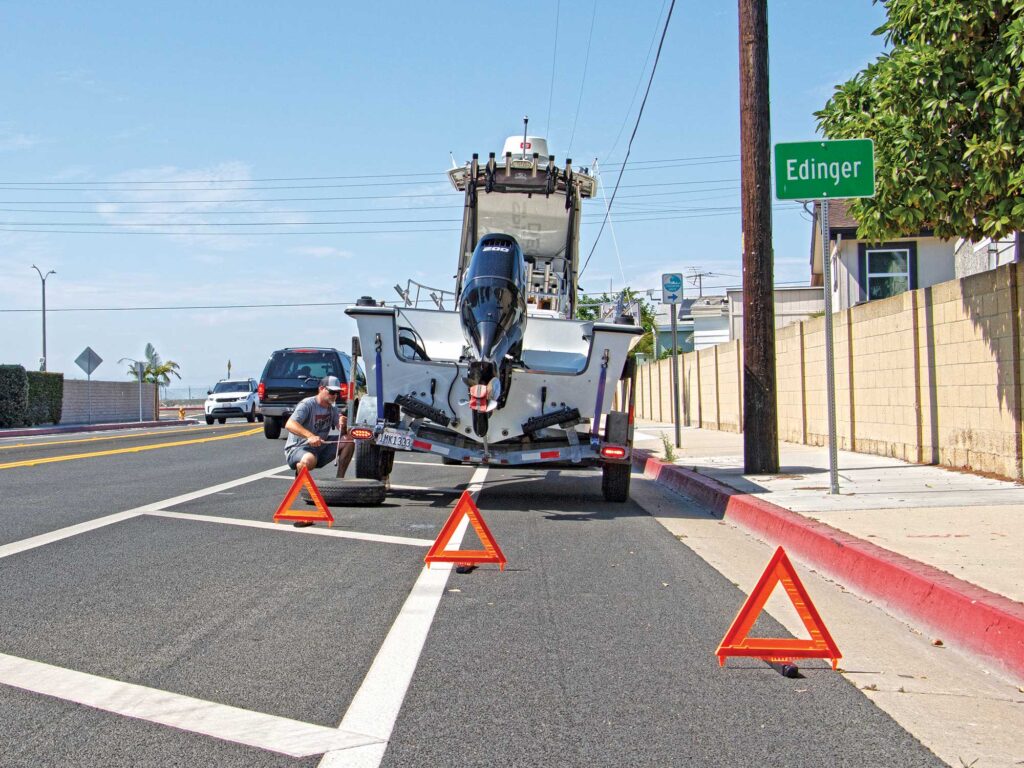 Safety is priority number one when assessing or repairing trailer problems.
Jim Hendricks
Use the Right Lane
Safety is priority number one when assessing or repairing trailer problems.
Jim Hendricks
Use the Right Lane
Knowing that a boat-trailer emergency can happen at any time, wise trailer boaters always use one of the right-hand lanes when towing on a multilane highway. Many states make these kinds of lane restrictions a legal requirement for any vehicle towing a trailer.
The rationale is that these lanes are for slower vehicles such as those pulling a trailer, and that you can more readily reach the right shoulder or a freeway exit in case of an emergency. It also prevents the dreadful situation of being stuck in the emergency lane next to the center divider.
This practice saved my bacon a few years ago when the right front tire of my tandem-axle blew out. I was towing in the far-right lane on an infamous and unforgiving Los Angeles freeway, and so by staying to the right, I was able to expeditiously get over to the shoulder and safely change the tire.
Out of Harm’s WayJacobs offers strong warnings to trailer boaters who need to pull off to the side of the highway in an emergency. “Vehicle traffic is your biggest enemy, a danger that’s greatly amplified at night,” he says. “So be very careful, and try to get off the roadway as far as safely possible to help ensure that you, your passengers, and your rig are all of out of harm’s way.”
In fact, the shoulder of the highway is so precarious that the veteran towing provider suggests that trailer boaters do their best to get off the highway altogether. “Don’t be afraid to keep going to the next off-ramp, especially if it’s fairly close,” he advises. “You might be dragging a flat tire, and you will need to slow down and put your hazard lights on as you limp to the next exit, but it will be easier and safer to deal with the emergency once you are completely off the highway.”
Once you do stop, be cautious when getting out of your vehicle. For safety’s sake, it might be a good idea to exit on the passenger’s side. Make sure your hazard lights are on, and put out those reflective road triangles or LED flashing lights behind your rig.
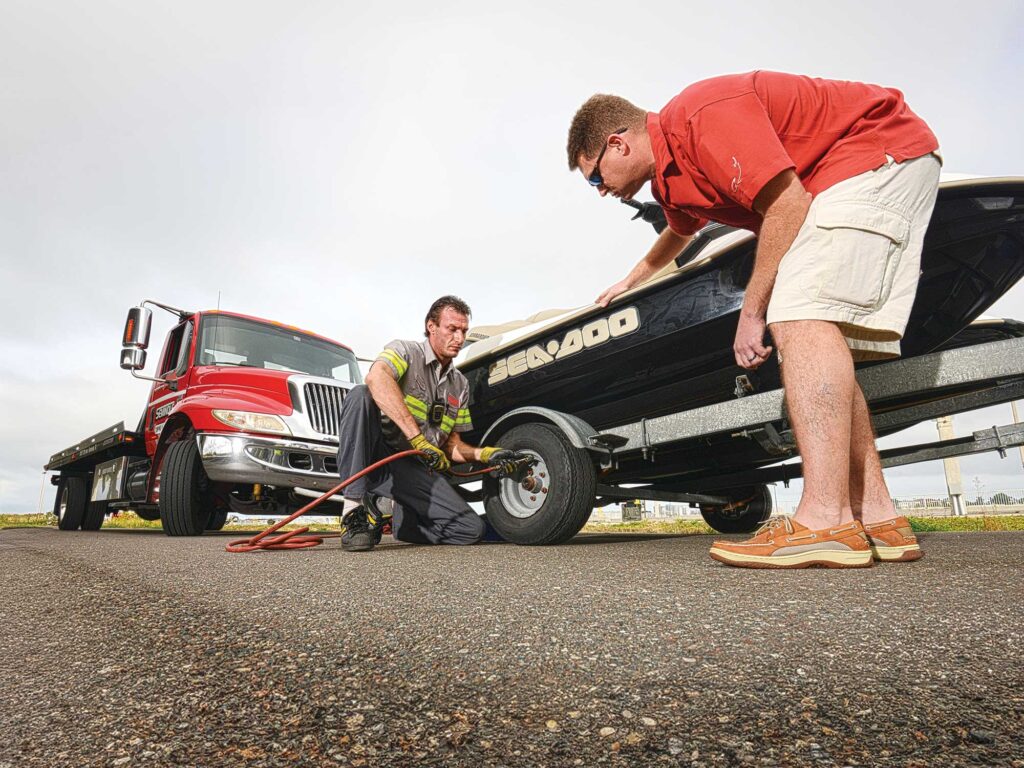 Towing assistance providers can typically make trailer checks before hauling your boat or PWC away.
Courtesy BoatUS
Calling for a Tow
Towing assistance providers can typically make trailer checks before hauling your boat or PWC away.
Courtesy BoatUS
Calling for a Tow
Some breakdowns might exceed your ability to fix things on the spot. For instance, burnt spindles, broken springs, bent axles and busted crossmembers do not lend themselves to quick or easy roadside repairs. In such cases, you will need call for a tow to move your boat and trailer.
But you likely won’t get what you need from a conventional auto-towing provider such as AAA. “A boat trailer is a totally different animal from a car or truck,” Jacobs points out. Boat trailers require different towing equipment and different thinking.
For example, a conventional tow truck—even one equipped with a hitch to tow a trailer—is fairly useless if the trailer boat cannot be towed. “That’s why nearly all BoatUS Trailer Assist providers use flatbed trailers,” Jacobs says.
That brings us back to my brother’s boat. After assessing the damage, I asked, “Don’t you have the Trailer Assist option from BoatUS?” His eyes lit up. “I almost forgot,” he answered. “Yes, I do!” With the peace of mind that we could get his 17-foot G3 boat and trailer to a repair shop later in the day, we decided to limp over the ramp, put the boat into the water, and go fishing for a few hours.
Later, as we wrapped up our fishing session, we called the BoatUS hotline while still on the lake and arranged to have a Trailer Assist provider meet us with a flatbed truck in the launch-ramp parking lot. The operator gave us an ETA, and we had the boat back on the trailer just in time to winch onto the flatbed. We followed the provider to a trailer shop in the area that we had prearranged to handle the repairs. Everyone was super-friendly, and the whole process flowed like clockwork. Quite a relief.
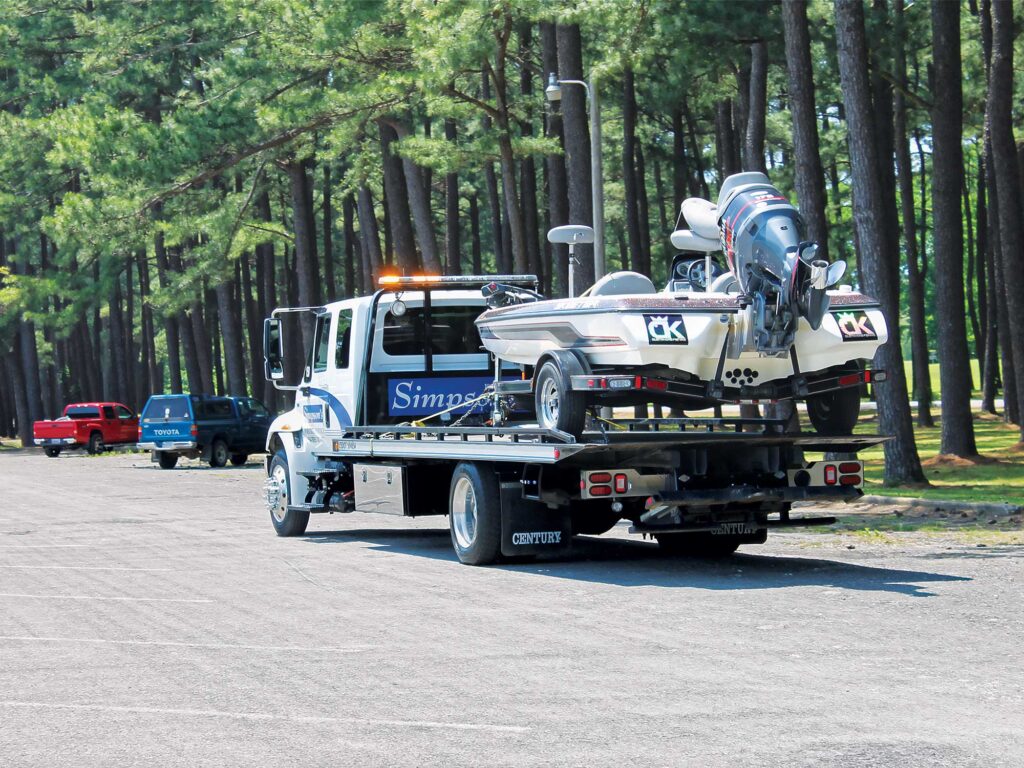 Flatbed trailers are typically needed for transporting to a repair center.
Jim Hendricks
Tall Order
Flatbed trailers are typically needed for transporting to a repair center.
Jim Hendricks
Tall Order
With small, low-profile trailer boats, flatbed trucks work well. But some trailer boats—such as those with hardtops, high-profile power cats, and even pontoon boats—can be fairly tall, perhaps too tall when winched atop a flatbed truck to fit under highway overpasses, overhanging tree branches, or even overhead power lines. Also, as trailer boats grow in size, some might exceed the 24-foot maximum length for a flatbed truck.
In these cases, BoatUS Trailer Assist providers look to alternatives. To help in this process, the boat owner should know and advise the BoatUS operator of the maximum height and length of the boat and trailer. “In some cases, we might need to enlist the assistance of a specialty wrecker such as a low-boy trailer,” Jacobs says. “These are 2 feet lower than a flatbed truck and usually employed to tow heavy construction equipment.”
Another alternative in such situations as busted axles is a dolly, which consists of a pan with wheels that is placed under the damaged portion of the trailer so that it rolls while being pulled by a conventional tow truck.
Ultimately, if trailer boating is your game, preparation is the key—not only in avoiding breakdowns, but also in dealing with them if and when they eventually occur.
The post Planning for a Boat-Trailer Breakdown appeared first on Boating Mag.
- Home
- About Us
- Write For Us / Submit Content
- Advertising And Affiliates
- Feeds And Syndication
- Contact Us
- Login
- Privacy
All Rights Reserved. Copyright , Central Coast Communications, Inc.